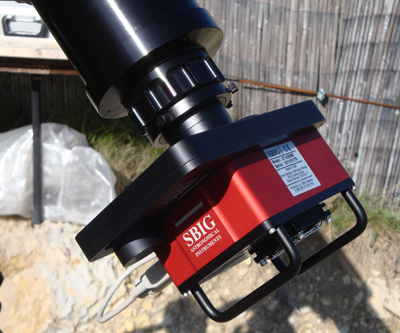
ASI2600MM
In 2022 I bought the AIS2600MM, together with Arno-Mark Blesgraaf, for our remote observatory in France. We use a 7 position filterwheel with Baader LRGB filters, an Astrodon 5nm H-alph afilter and an Astrodon 3 nm O3 filter. Unfortunetly the camera was leaking oil and we had to replace it.

ST-8300M
Since 2011 I use this ST-8300M with a 5-position filterwheel. Later I bought a 8 position filterwheel. I use Baader LRGB filters, an Astrodon 5nm H-alph afilter and an Astrodon 3 nm O3 filter. With the TEC I take luminance and RGB exposures binned 1x1.

Canon 40D
In december 2008 I bought a Canon 40D DSLR camera. The company Baader modified the camera for H-alpha astrophotography. This camera is better than the Canon 20Da. It has less noise. The blue corners at the right, which were always visible with the 20Da in exposures of several minutes, are not existant with the 40D. The Live View mode is even better then with the 20Da, because it is no longer necessary that the star is in the middle of the field. Focussing on a bright star with the 25cm Meade with 40D live view and a Bahtinovmask is done in a few seconds.
In the summer of 2009 I constructed a box with a peltier element to cool the camera. It takes one and a half hour to cool the camera, but then the the temperature is 12° C cooler then the ambient temperature.
When the sky is clear and there is no or little light polution, I take images of 10 minutes and no pause between the exposures.

Canon 20Da
In 2005 Canon came with a DSLR camera optimized for astrophotography, the 20Da. The two most important features of the camera were on that moment:
- Live view mode. To ensure a sharp focus, the central portion of the image can be magnified on the LCD by 5x (4% of the picture area) or 10x (1% of the picture area). I think this real time focussing mode is the most important feature. For fine focussing take a star witch is not to bright. While focussing in the 10x mode (FC2) you see the star appearing and disappearing.
-
The low-pass filter positioned in front of the sensor has been modified to increases the transmission of light at the
- for astrophotographers important -
wavelength of 656nm, the Hydrogen Alpha line, by a factor of 2.5x compared to the standard EOS 20D digital SLR.
The standard 20D digital SLR transmits 20% of this 656nm wavelength, the 20Da transmits 69%. The company Hutech modifies camera's witch transmit even 95%, but then it is not longer possible to use the camera for "normal" use.
